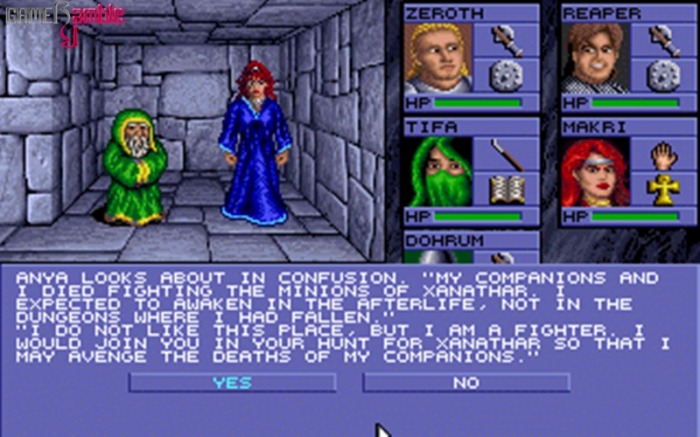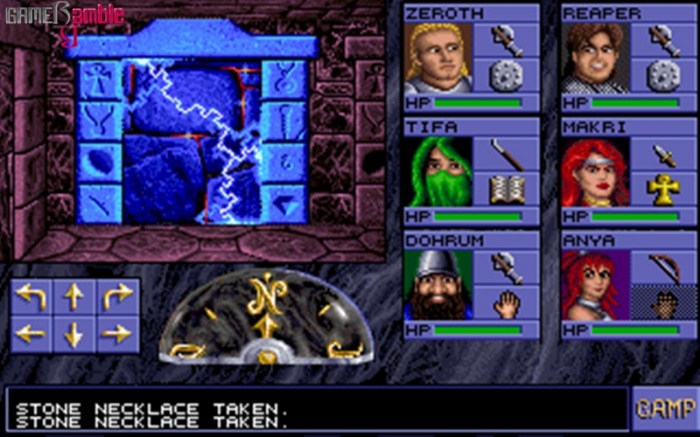Eye Of The Beholder
Developer: Westwood Associates | Publisher: Strategic Simulations Inc. | Release Date: 1991 | Genre: First Person RPG | Website: n/a | Purchase: GOG
There is an ancient evil stirring in the town of Waterdeep and no-one knows what it is. All evidence seems to point towards the vast labyrinth of tunnels beneath the city and a group of heroes is needed to purge it. It’s up to you to explore the tunnels and find out what evil plot is brewing. Well that and grab as much treasure as you can as you have full rights of Marque to keep everything interesting you find. And so begins your quest on the 5th day of Marpenoth in the year of shadows.
Eye of the Beholder is a first person RPG that uses the Advance Dungeons and Dragons rules, so a bit of rule studying is needed before jumping into the game. Although all of the dice rolling and other things are handled behind the scenes it’s still a good idea to check out what’s the deal with all the different character classes, alignment and spells. The AD&D rules differ a bit from your usual RPG fare and can make the game much more complex. The basic idea is to wander through a twelve level deep dungeon killing enemies and finding items. A bunch of keys need to be found to go down deeper and a few vital items are required to complete your quest. It’s a pity that the game features very little character interaction and about the only non-hostile characters you encounter are some dwarves that live on the sixth level. Other than a few lines of text now and then you’re mostly killing things. Combat takes place in real time, which can be a bit hectic as you have to control up to six characters at once. Using potions and scrolling through spell books needs to be done quickly if you want to still have anyone alive at the end of the battle. Only characters in the front row can attack with short range weapons while those at the back have to rely on projectiles and spells to cause damage. At least the interface is quite streamlined and everything can be handled easily with a mouse/keyboard combo. Your characters move in the usual one step at a time mode and the viewing area is also quite small.
Although the dungeons are quite complex and feature a multitude of puzzles and traps there is no auto-map feature. Since I hate drawing maps I was lost most of the time, but with some clever use of redundant items you can leave yourself a handy trail.
You also only have one save spot so to avoid heartache I advise you copy your old savegames to a safe place before trying something dangerous. A nice touch is that from time to time you find the bones of a character that wasn’t so lucky in their quest. These can be carried back to the dwarves who will then resurrect the character to join your party. You start out with four initial characters you create yourself, although any character can be dropped to make space for a new one. As long as you don’t go over your limited of six characters.
The game is packed with traps, hidden rooms, secret passages and portals. Making your way through all this is quite an achievement and only the very patient (and lucky) will make it down to the bottom level and still remain sane. Fortunately, there are some portals that can teleport you around providing you find the correct portal keys. This is handy for backtracking up to the higher levels without trudging all the way back up. Just remember to keep notes of what leads where and search thoroughly for the keys.
Although the graphics in the game is quite nice for such an old title the sound is a bit disappointing. There is very little music and the Adlib sound effects are little more than white noise. A few atmospheric tunes and some proper samples would have added a lot to the game. The controls can be awkward at first, but you’ll get used to it as the game progresses. It’s still possible to get hopelessly disorientated while running away from monsters, but playing the game with a mouse/keyboard combo works well. Walking one step at a time and not smooth scrolling also takes some getting used to.
If you like your games complex and tough then Eye of the Beholder will provide hours of entertainment. Although at times it feels like some parts were made intentionally complex just to sell the strategy guide it’s still possible to complete the game without losing too much hair. It can be frustrating as hell at times, but completing the game provides quite a feeling of achievement. Since this is the start of a series I can only hope the following game’s build on this games strengths and add even more cool features.
*Review originally published 1997.
System Requirements
OS: Windows: XP / Vista / 7 / 8 / 10
Processor: 1.8 GHz Processor
Memory: 512MB RAM (1 GB recommended)
Graphics: 3D graphics card compatible with DirectX 7 (compatible with DirectX 9 recommended)
Hard Drive: 2GB HDD
Mouse, Keyboard
OS: OS X 10.7.0 or later
Processor: 1.8 GHz Processor
Memory: 512MB RAM (1 GB recommended)
Graphics: 3D graphics card compatible with DirectX 7 (compatible with DirectX 9 recommended)
Hard Drive: 2GB HDD
Mouse, Keyboard
OS: Ubuntu 14.04, Mint 17
Processor: 1.8 GHz Processor
Memory: 512MB RAM (1 GB recommended)
Graphics: 3D graphics card compatible with DirectX 7 (compatible with DirectX 9 recommended)
Hard Drive: 2GB HDD
Mouse, Keyboard















